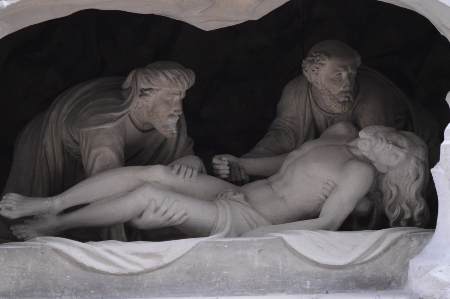 Dear readers, Catholic Online was de-platformed by Shopify for our pro-life beliefs. They shut down our Catholic Online, Catholic Online School, Prayer Candles, and Catholic Online Learning Resources essential faith tools serving over 1.4 million students and millions of families worldwide. Our founders, now in their 70's, just gave their entire life savings to protect this mission. But fewer than 2% of readers donate. If everyone gave just $5, the cost of a coffee, we could rebuild stronger and keep Catholic education free for all. Stand with us in faith. Thank you. Help Now >
Dear readers, Catholic Online was de-platformed by Shopify for our pro-life beliefs. They shut down our Catholic Online, Catholic Online School, Prayer Candles, and Catholic Online Learning Resources essential faith tools serving over 1.4 million students and millions of families worldwide. Our founders, now in their 70's, just gave their entire life savings to protect this mission. But fewer than 2% of readers donate. If everyone gave just $5, the cost of a coffee, we could rebuild stronger and keep Catholic education free for all. Stand with us in faith. Thank you. Help Now >
Researchers find Shroud of Turin Dates to Time of Jesus Christ
FREE Catholic Classes
The Shroud of Turin, a revered linen cloth believed by many to be the burial shroud of Jesus Christ, has mystified believers, historians, and scientists for centuries. First presented to the public in the 1350s, this holy relic has long been proclaimed as the very cloth that wrapped Christ's mutilated body following His crucifixion.

Photo credit: dodo71
Highlights
8/19/2024 (7 months ago)
Published in Living Faith
Keywords: Shroud of Turin, Holy Shroud, Jesus Christ, crucifixion, Catholic faith, linen relic
The Shroud, also known as the Holy Shroud, bears a faint image of a bearded man, strikingly reminiscent of traditional depictions of Jesus. For many, this image is not merely symbolic but is believed to be the miraculous imprint of Christ Himself, left on the linen by divine power.
While the authenticity of the Shroud was questioned in the 1980s after carbon dating seemed to place its origins in the Middle Ages, new research has reignited the debate. Italian scientists, employing a cutting-edge technique using X-rays, have now dated the Shroud to around 2,000 years ago, aligning it with the time of Jesus' life and death.
The Bible recounts that Joseph of Arimathea, a disciple of Jesus, wrapped the body of Christ in a linen shroud before placing it in a tomb. Matthew 27:59-60 describes this sacred moment: "Then Joseph took the body and wrapped it in a new linen cloth. He put Jesus' body in a new tomb that he had dug in a wall of rock. Then he closed the tomb by rolling a very large stone to cover the entrance."
Since its first public display, the Shroud has captivated the imagination and devotion of the faithful. Preserved since 1578 in the royal chapel of the Cathedral of San Giovanni Battista in Turin, Italy, the cloth reveals the faint, brownish images of a man whose physical suffering mirrors the accounts of Christ's Passion. The markings correspond to the crucifixion wounds described in the Bible, including thorn marks on the head, lacerations on the back, and bruises on the shoulders, likely caused by the heavy cross Jesus bore.
The Shroud's authenticity has been the subject of intense scrutiny, particularly following the 1988 carbon dating, which suggested it was only seven centuries old. However, this recent study, conducted by the Institute of Crystallography of the National Research Council of Italy, offers compelling evidence to the contrary. By analyzing the natural aging of flax cellulose in the Shroud using wide-angle X-ray scattering (WAXS), researchers determined that the linen likely dates back to the first century AD, closely aligning with the lifetime of Jesus.
Dr. Liberato De Caro, the lead author of the study, challenges the accuracy of the 1988 carbon dating, attributing the discrepancy to potential contamination of the samples. According to Dr. De Caro, "Fabric samples are usually subject to all kinds of contamination, which cannot be completely removed from the dated specimen." He suggests that this contamination may have skewed the earlier results, pointing to more recent findings that show a significant increase in carbon-14 as one moves from the periphery towards the center of the Shroud.
Over the years, more than 170 peer-reviewed academic papers have examined the Shroud, with many concluding it to be authentic. Various tests, including those conducted in the 1970s, have explored whether the images on the Shroud were created through painting, scorching, or other methods, but none could be confirmed. In 2017, another group of experts found evidence of substances like creatinine and ferritin on the Shroud, typically present in victims of severe trauma, further supporting the idea that the Shroud bears the blood of a torture victim, consistent with the suffering of Jesus Christ.
As modern science continues to explore this sacred relic, the Shroud of Turin remains a powerful symbol of faith for millions of Catholics worldwide. For believers, the Shroud is not just a historical artifact but a profound testament to the life, death, and resurrection of Jesus Christ.
Join the Movement
When you sign up below, you don't just join an email list - you're joining an entire movement for Free world class Catholic education.

-

- Stations of the Cross
- Easter / Lent
- 5 Lenten Prayers
- Ash Wednesday
- Living Lent
- 7 Morning Prayers
- Mysteries of the Rosary
- Litany of the Bl. Virgin Mary
- Popular Saints
- Popular Prayers
- Female Saints
- Saint Feast Days by Month
- Pray the Rosary
Honoring Pope St. John Paul II: A Legacy of Faith, Hope, and Human Dignity
A Glimpse into the Face of St. Teresa of Ávila: Scientific Reconstruction Reveals Remarkable Details
Vice President JD Vance Plans Easter Weekend Visit to Rome, Meeting with Italian Leaders Uncertain
Daily Catholic
 Daily Readings for Thursday, April 03, 2025
Daily Readings for Thursday, April 03, 2025 St. Richard of Wyche: Saint of the Day for Thursday, April 03, 2025
St. Richard of Wyche: Saint of the Day for Thursday, April 03, 2025 Prayer for God's Help in Daily Actions: Prayer of the Day for Friday, March 14, 2025
Prayer for God's Help in Daily Actions: Prayer of the Day for Friday, March 14, 2025 Daily Readings for Wednesday, April 02, 2025
Daily Readings for Wednesday, April 02, 2025 St. Francis of Paola: Saint of the Day for Wednesday, April 02, 2025
St. Francis of Paola: Saint of the Day for Wednesday, April 02, 2025- To Perceive Animals as God's Gifts: Prayer of the Day for Thursday, March 13, 2025
![]()
Copyright 2025 Catholic Online. All materials contained on this site, whether written, audible or visual are the exclusive property of Catholic Online and are protected under U.S. and International copyright laws, © Copyright 2025 Catholic Online. Any unauthorized use, without prior written consent of Catholic Online is strictly forbidden and prohibited.
Catholic Online is a Project of Your Catholic Voice Foundation, a Not-for-Profit Corporation. Your Catholic Voice Foundation has been granted a recognition of tax exemption under Section 501(c)(3) of the Internal Revenue Code. Federal Tax Identification Number: 81-0596847. Your gift is tax-deductible as allowed by law.


 Daily Readings for Thursday, April 03, 2025
Daily Readings for Thursday, April 03, 2025 St. Richard of Wyche: Saint of the Day for Thursday, April 03, 2025
St. Richard of Wyche: Saint of the Day for Thursday, April 03, 2025 Prayer for God's Help in Daily Actions: Prayer of the Day for Friday, March 14, 2025
Prayer for God's Help in Daily Actions: Prayer of the Day for Friday, March 14, 2025 St. Francis of Paola: Saint of the Day for Wednesday, April 02, 2025
St. Francis of Paola: Saint of the Day for Wednesday, April 02, 2025

